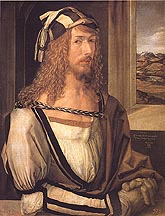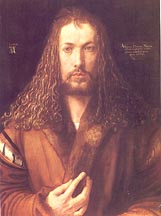Woodcut- a print made from a design raised in relief on a wooden block. All parts of the design which are not to be printed are cutr away with knives and gouges; therefore it is a negative or subtractive process which does not directly register the lines made by the hand of the artist as in engraving.
Engraving- a print made from a design cut with a burin into a metal plate. Engraving is an "intaglio" process rather than a relief process like woodcut, i.e. lines are cut into the surface of the plate and it is these lines that are printed, whereas, in making a woodcut, the spaces between the lines of the design are cut away, leaving the lines raised in relief.
Excerpt from letter dated Sept. 8, 1506 from Dürer while in Venice to Willibald Pirckheimer: ...My picture [the Rose Garland Altar] if you must know, says it would give a ducat for you to see it; it is well painted and beautifully colored. I have earned much praise but little profit by it. In the time it took to paint it I could easily have earned two hundred ducats, and now I have declined much work so that I can come home. And I have stopped the mouths of all the painters who used to say that I was good at engraving but, as to painting, I didn't know how to handle my colors. Now everyone says they have never seen more beautiful colors....
Excerpt from letter dated October 1506 from Dürer while in Venice to Willibald Pirckheimer: I shall have finished here in ten days; after that I should like to ride to Bologna to learn the secrets of the art of perspective, which a man is willing to teach me. I should stay there eight or ten days and then return to Venice. After that I shall come with the next messenger. How I shall freeze after this sun! Here I am a gentleman, at home only a parasite.
 |
 |
| Albrecht Dürer, Self-Portrait, 1498 (Prado) | Albrecht Dürer, Self Portrait, 1500 (Münich) |